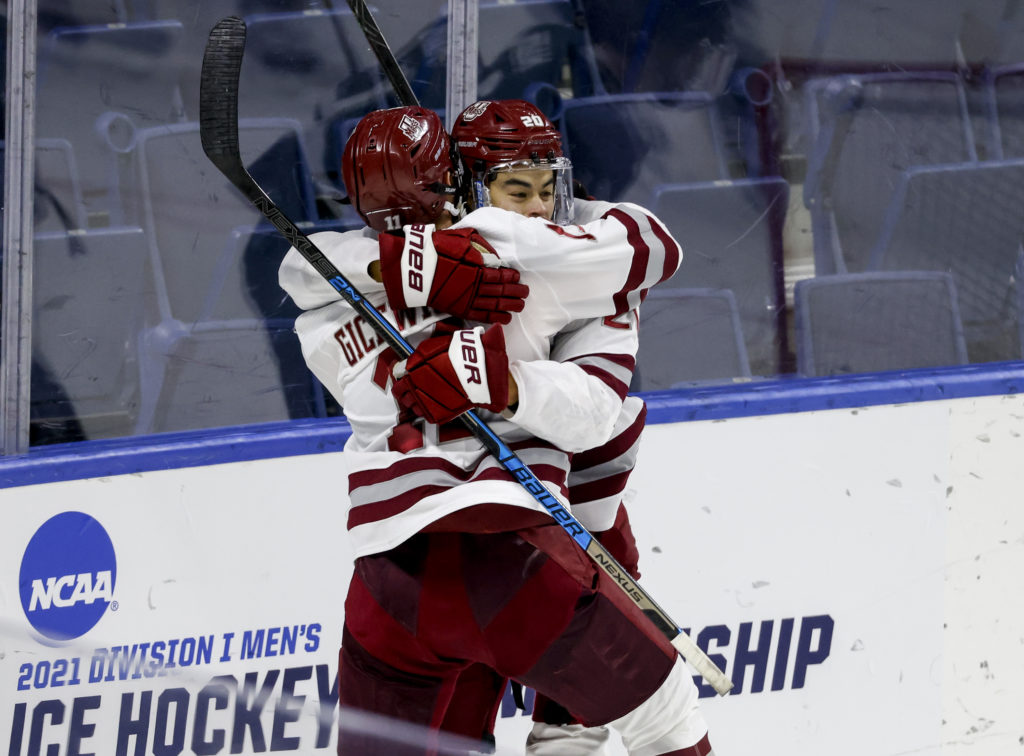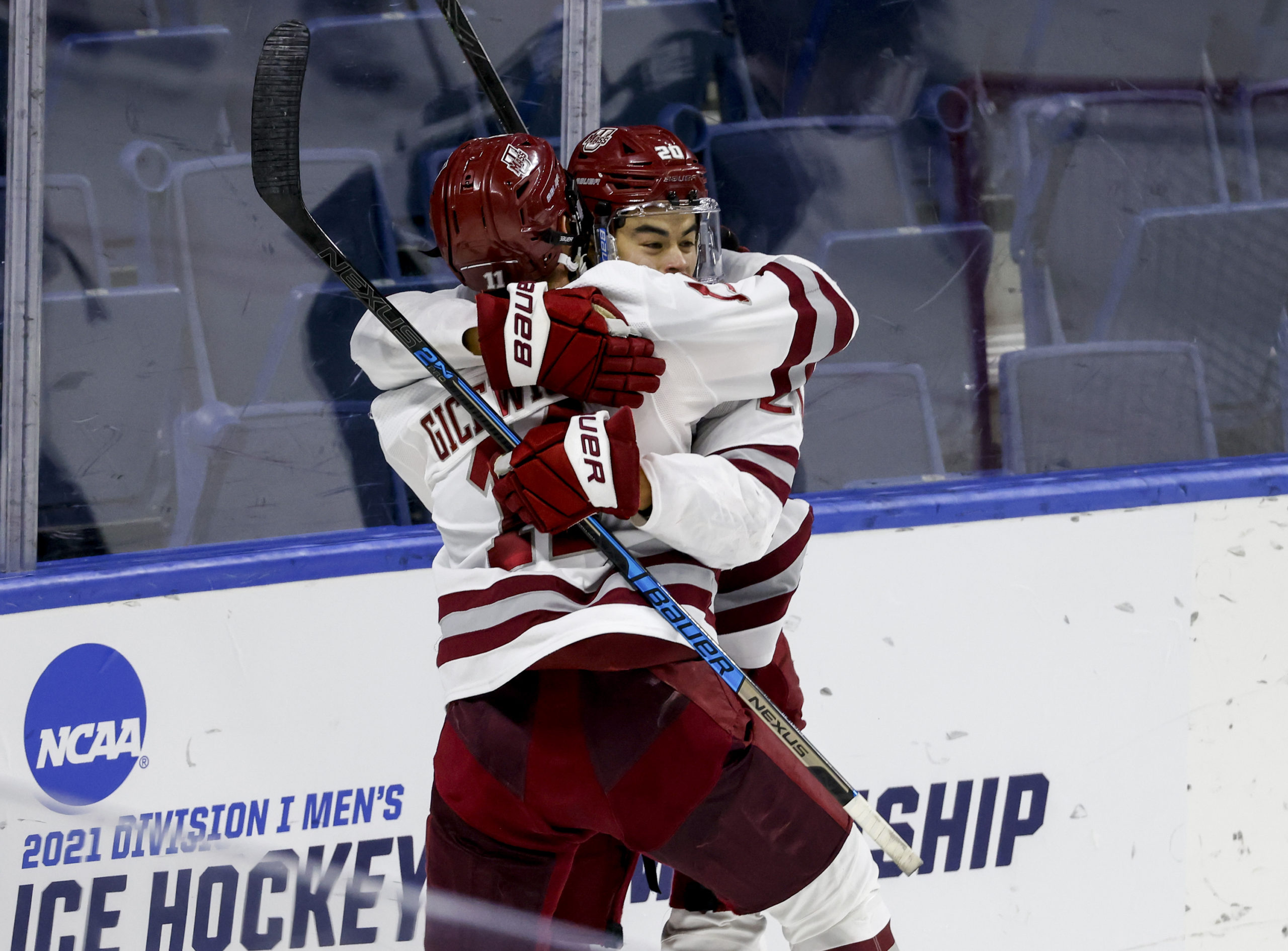
Each week during the season, we look at the big events and big games around Division I men’s college hockey in Tuesday Morning Quarterback. NOTE: This is our final TMQ of the 2020-21 season.
Jim: Well, Paula, the Frozen Four field is set and a pretty unique field it is.
You have three teams looking for their first title in Massachusetts, St. Cloud State and Minnesota State. The fourth team is looking for just the second other three-peat, that’s Minnesota Duluth.
The state of Minnesota has three teams in the field, something that happened only once before in 1992.
But something that stands out to me is that of the 10 Hobey Baker finalists that were playing when the tournament began only one, Dryden McKay is the only one left standing.
Nine very talented players took very talented teams into the tournament and came away empty, while three teams without Hobey finalists are headed onto Pittsburgh.
Which leads me to my question: are we learning that high-end talent doesn’t translate well in the national tournament? That sometimes it’s more about grit, determination and experience?
Paula: I think your question about high-end talent and the national tournament is an interesting one.
I’m reminded of interviewing 1997 Hobey Baker winner, Brendan Morrison, and how devastated he was that Michigan had lost its semifinal game to Boston University the night before the Hobey ceremony. Morrison said, “We had a successful year, and we did all the little things along the way, and sometimes the best team doesn’t win.”
Morrison took a lot of heat for that comment, and anyone who knew him then knew he meant no disrespect to the Terriers. Also, Morrison knew how talented that group of Wolverines was. Michigan won the championship both the year prior and the year after.
College hockey has changed so much since then.
It’s increasingly more difficult to retain top talent beyond a couple of years, so programs loaded with elite, drafted or draft-eligible players are having to reconfigure nearly annually, seeing an even higher turnover of players than what’s common among all teams. That is something that may favor teams that can’t compete for those high-end players. Beyond keeping a core of players together longer, teams like Mankato and St. Cloud also recruit guys that are super-specific to their programs and their schools.
It’s not that high-end players aren’t committed to the schools they attend, but there is something to be said for players who aren’t thinking about leaving early, who know that they’re committing for their full eligibility when they sign their letters of intent.
There may be something to the grit and determination you mention, especially for programs that perceive that they’re not given the respect they deserve. As for experience, we saw that with the Bulldogs – and maybe we see it with teams that have experience playing together, regardless of their experience in the national tournament.
I do think it’s too difficult to answer your question completely, though, Jim. We’ve talked a lot about how COVID has affected teams this season and readers may be weary of hearing it, but it’s impossible for me to think of this season as anything but unique unless subsequent seasons bear out the same results.
That having been said, there is an interesting trend in the Frozen Four field in the last decade or so. This year, Minnesota State becomes the 12th team since 2008 to make its first Frozen Four appearance. It’s been six years since the last time we saw a newcomer to the field – Omaha in 2015 – but this overall trend may help answer your question better.
Looking at the last 13 years, Jimmy, it has to be more than just grit and determination that’s helped so many newcomers advance to the Frozen Four, right? Although, I don’t want to discount those qualities – plus experience – in a season when there was so much else going on.
Jim: One thing that I often point to when we see programs that have not had a long track record of success suddenly succeed is institutional commitment.
Resources, specifically financial, may go further in hockey than many other sports, in particular football and basketball. In those sports, you can spend and spend and still never compete for a national championship.
But with hockey, I think it was helpful for programs like Union, Yale, Minnesota Duluth and Providence to all have success in the last decade or so. Let me look at a couple of programs I’ve been around for years – UMass Lowell and UMass. The River Hawks had some decent success in the mid 1990s but never won anything. After years of frustration, that school increased investment and resources and that finally translated to a return to the NCAA tournament in 2012 and then a Hockey East championship the following year. Lowell has now advanced to six of the last eight Hockey East title games, winning three, and reached a Frozen Four in 2013.
For UMass, part of the same system, I believe there was a hunger to replicate what their sister school accomplished. They put a lot of time and effort into bringing in the right coach in Greg Carvel and have committed more financially than in the past. It took a few years, but ultimately there was success.
That’s a microcosm of many programs in the nation. Maybe it’s a team that wants to invest so that they can be better within their conference, like AIC, or a program like Minnesota Duluth that continued to increase investment and watched it translate into three national title. And maybe four.
What resulted, though, is many new faces on a national stage. Some may think it’s not good for the overall college hockey brand. Certainly people know a lot more about, say, Minnesota than Minnesota State. But I, for one, think it’s exciting.
Paula: I’m with you.
The new faces in the tournament this past decade or so has been very exciting for college hockey fans. Those people we know who argue that seeing teams like Minnesota State in the tournament doesn’t do much to elevate college hockey may or may not be correct. The Mavericks don’t have the name recognition that the Golden Gophers do, but honestly, how much have the name brands – so to speak – heightened the profile of the game overall?
When the Big Ten formed and many college hockey fans groused about how it forced realignment, there were many others who countered that having such high-profile programs featured regularly on nationally televised games would bring new fans to the sport. I don’t have the statistics on this, but I’m pretty sure that college hockey didn’t experience a proliferation of new admirers.
We all want to grow the sport’s base, but we can’t look past one of the key things that makes college hockey so exciting – and that is seeing teams like Omaha, Union, RIT and now Minnesota State advance to the Frozen Four.
Now, I don’t have the statistics on this, either, but I think we’ve seen college hockey gain more fans because of the number of NHL players the NCAA is producing.
Jim: If there is a reason for a significant gain in reach for college hockey it is the realization that more than one-third of the NHL is comprised of former college players.
That said, I still hope there is a reason to expand this game and doing so at larger schools would be beneficial. I would really like to see the PAC-12 give serious consideration to finding enough schools to form another Power 5 conference. The SEC also has enough hockey and seriously passionate fan bases to grow in those necks of the woods.
This probably wasn’t the direction that you thought this final TMQ of the year would take. But I think it merits a lot of thought.
Paula: This definitely merits thought. This is the perfect time to begin to look ahead – maybe way ahead – beyond this season.
There is an astonishing amount of club hockey being played at colleges and universities across the U.S., and so much of it at institutions with high profiles. In Florida, the Hurricanes, Gators and Seminoles all play hockey. Auburn University, the University of Alabama, the University of Georgia, and Louisiana State all have club teams. The Texas Collegiate Hockey Conference is an American Collegiate Hockey Association (ACHA) league with eight teams, including Texas A&M and the University of Texas.
There are over 400 ACHA teams, including 70 playing D-I ACHA hockey. There are teams from coast to coast and corner to corner in the U.S., including a PAC-8 league.
There are kids growing up playing hockey everywhere, hockey being played everywhere, and thousands of guys playing hockey for their schools outside of the 61 NCAA D-I and 84 NCAA D-III programs. There are tens of thousands of fans of those club teams, too.
Among those tens of thousands of fans must be people willing and able to commit the money necessary to starting programs. We know that schools are willing to commit to hockey when they’re not burdened with all of the start-up costs themselves.
We used to think that it was only a matter of time before we’d see something like a PAC-12 or SEC hockey league, but certainly the pandemic and financial uncertainty that it has brought has pushed that back for a bit.
But it’s hard to deny the potential and I cannot imagine a not-so-distant future without further D-I NCAA growth. As you said, Jimmy, with more than a third of NHL players having come through the NCAA, there’s no denying that collegiate hockey can develop talent. You can’t watch an NHL game without hearing colleges being named in the way that we’ve heard schools mentioned in NBA and NFL games now for decades. That has an impact.
Beyond that, though, is just the sheer number of kids playing hockey in the U.S. and the growth of the sport among youth in just the last two decades. It’s inevitable that colleges and universities will see the potential for attracting students, fans, recognition – and donors – as hockey continues to proliferate.
As you mentioned, Jimmy, it’s the final TMQ of the season. I want to thank you for talking hockey with me all season, thank our friend and editor Matt Mackinder, thank Dan Rubin for subbing when he filled in, and thank all of our readers who have helped maintain our ongoing conversation about the sport we love.
